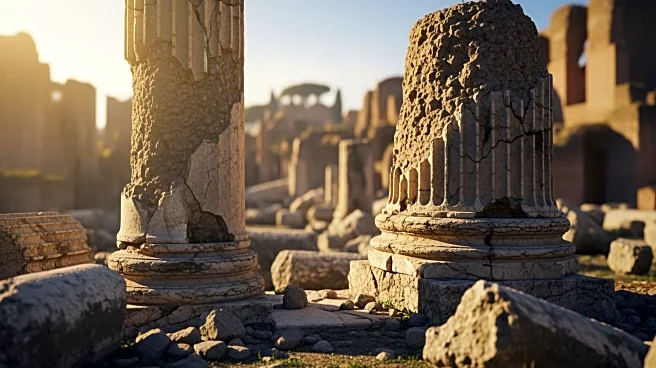What's Happening?
The Torre dei Conti, a medieval tower located near Rome's Colosseum, partially collapsed on Monday. The incident resulted in serious injuries to a worker and trapped another inside the structure. Italian
officials reported that emergency workers are actively trying to rescue the trapped individual. The rescue operation is complicated by the instability of the remaining structure. According to Luca Cari, a spokesman for Rome's fire department, the trapped worker has shown signs of life, but his exact condition remains unclear. Lamberto Giannini, Rome's prefect, described the rescue as a 'long and complex operation' due to the safety risks involved for the rescuers.
Why It's Important?
The collapse of the Torre dei Conti highlights the challenges of preserving historical structures while ensuring safety. This incident underscores the potential risks involved in restoration projects of ancient buildings, which are often structurally fragile. The event may prompt a reevaluation of safety protocols and restoration practices in Italy and other countries with significant historical architecture. The situation also raises concerns about the safety of workers involved in such projects, potentially leading to stricter regulations and oversight. The broader impact could affect tourism, as Rome's historical sites are major attractions, and any perceived safety issues could influence visitor numbers.
What's Next?
Rescue efforts are ongoing, with emergency teams working to safely extract the trapped worker. The outcome of this operation will likely influence future restoration projects, possibly leading to increased safety measures. Authorities may conduct a thorough investigation to determine the cause of the collapse and prevent similar incidents. The incident could also lead to discussions among policymakers and preservationists about balancing historical preservation with modern safety standards. The response from the Italian government and international heritage organizations will be crucial in shaping future restoration practices.
Beyond the Headlines
The collapse of the Torre dei Conti may have deeper implications for cultural heritage preservation. It raises ethical questions about the responsibility of maintaining historical sites while ensuring public and worker safety. The incident could spark a broader debate on the allocation of resources for preserving ancient structures versus investing in modern infrastructure. Additionally, it may influence cultural policies and funding priorities, as governments and organizations reassess the value and risks associated with maintaining historical landmarks.















